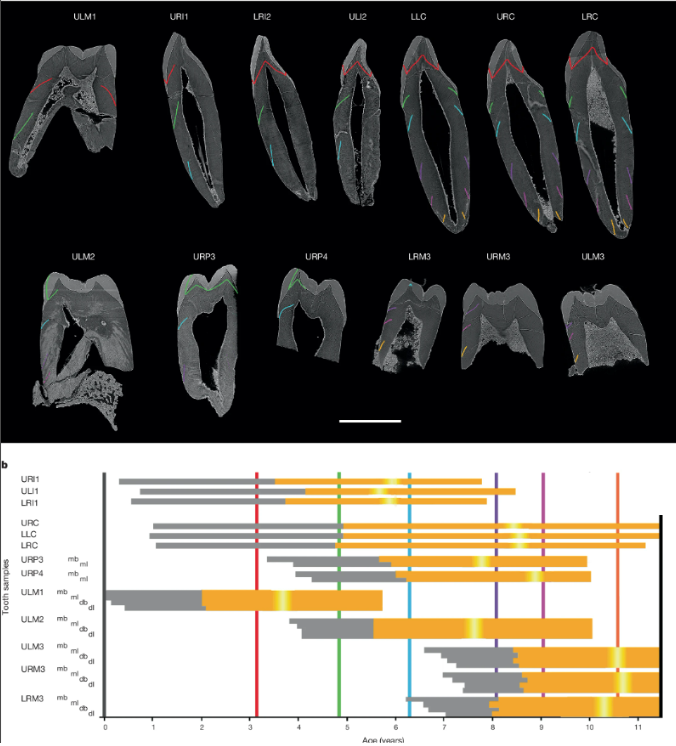Fossil teeth shed light on the length of ancient humans’ childhood – a prelude to big brain development
Introduction
The extended childhood observed in modern humans has long been associated with our increased brain size and complex social structures. Recent research challenges this perspective, suggesting that the prolonged developmental phase may have preceded significant brain enlargement. This article delves into the findings from a study on early Homo fossils from Dmanisi, Georgia, dated approximately 1.77 million years ago, to explore the implications of extended childhood in human evolution.
The Dmanisi Fossil Discovery
Dmanisi, located in Georgia, has yielded some of the most significant hominin fossils outside Africa. Excavations have uncovered skulls and teeth that provide insights into early human ancestors. Notably, a near-adult individual’s dental development was meticulously analyzed using synchrotron imaging, revealing patterns that suggest a prolonged childhood despite a brain size comparable to that of great apes.
Methodology: Synchrotron Imaging of Dental Development
Researchers employed advanced synchrotron imaging techniques to examine the dental growth of the Dmanisi fossil. This non-destructive method allowed for detailed analysis of the tooth microstructure, akin to tree rings, providing a chronological record of dental development from birth to death. The exceptional preservation of the specimen enabled a comprehensive reconstruction of its growth trajectory.

a–c, Computed tomography (CT)-based visualization of the skull and associated teeth showing right lateral (a), frontal (b) and left lateral (c) radiographic projections. d,f, Occlusal views of reconstructed mandibular (d) and maxillary (f) dentition (green, high-resolution PPC-SRµCT of isolated teeth used for microstructural analyses; orange, medium-resolution PPC-SRµCT of teeth in place, not included in microstructural analyses; red, low-resolution scans (medical CT, not included in analyses); light blue, missing teeth mirrored from preserved antimeres; dark blue, missing mandibular first incisors, reconstructed from second incisors). e, Frontal view of the skull. Scale bar, 5 cm. / The scientific journal Nature/Christoph P. E. Zollikofer

a, PPC-SRµCT cross-sectional images through the developmental planes of all analysed teeth (for abbreviations, see text). Coloured lines indicate the six major stress markers (hypoplasias) used for cross-matching the teeth. b, Composite chart showing dental development. Tooth abbreviations as in a; individual cusps: mb, mesiobuccal; ml, mesiolingual; db, distobuccal; dl, distolingual. Grey bars, crown formation periods from initiation to termination; orange bars, root formation periods (light bands mark maximum root extension rate as a proxy for dental eruption). The vertical coloured lines correspond to the stress events shown in a. Scale bar, 1 cm. / The scientific journal Nature/Christoph P. E. Zollikofer
Findings: Prolonged Childhood in Early Homo
The study revealed that the Dmanisi individual exhibited a dental maturation pattern similar to that of modern humans, with a slower development of molar crowns compared to the rapid eruption seen in great apes. This suggests that early Homo species experienced a longer period of dental development, indicating an extended childhood phase. Interestingly, this prolonged development occurred despite a brain size not significantly larger than that of contemporary great apes.
Implications for Human Evolution
These findings challenge the traditional view that increased brain size necessitated a longer developmental period. Instead, the extended childhood may have been a precursor to brain enlargement, providing the necessary time for complex social learning and cultural transmission. This extended period of dependency would have facilitated the accumulation and transfer of knowledge across generations, a hallmark of human societies.
The Role of Social Structures in Cognitive Development
The study also suggests that the extended childhood in early Homo species was supported by social structures that included multiple generations. Such a three-generation social framework would have enhanced the transmission of cultural knowledge and skills, further supporting the development of complex cognitive abilities. This underscores the importance of social bonds and cultural learning in the evolution of human intelligence.
Comparative Analysis: Humans and Great Apes
Comparing the dental development of early Homo to that of great apes reveals significant differences. While great apes reach adulthood rapidly, early Homo species exhibited a slower maturation process, particularly in dental development. This slower growth rate aligns with the extended childhood observed in humans, suggesting a unique evolutionary pathway distinct from that of our closest relatives.
Evolutionary Advantages of Prolonged Childhood
An extended childhood offers several evolutionary advantages:
- Enhanced Learning Opportunities: A longer developmental period allows for more extensive learning and adaptation to complex environments.
- Cultural Transmission: Prolonged dependency facilitates the transfer of cultural knowledge and practices, essential for survival and social cohesion.
- Social Bonding: Extended childhood periods strengthen social bonds within groups, promoting cooperation and mutual support.
Conclusion
The analysis of dental development in early Homo fossils from Dmanisi provides compelling evidence that an extended childhood preceded significant brain enlargement in human evolution. This prolonged developmental phase, supported by complex social structures, likely played a crucial role in the emergence of advanced cognitive abilities and cultural practices. Understanding this aspect of our evolutionary history offers valuable insights into the unique trajectory of human development.
Suggested Diagram: Dental Development Comparison
This diagram illustrates the comparative duration of dental development between early Homo species, which exhibited a prolonged childhood, and great apes, which have a more rapid developmental timeline.
Sources
- ScienceDaily – The secrets of fossil teeth revealed by the synchrotron: A long childhood is the prelude to the evolution of a large brain – November 14, 2024
- Nature – Dental evidence for extended growth in early Homo from Dmanisi – November 13, 2024









